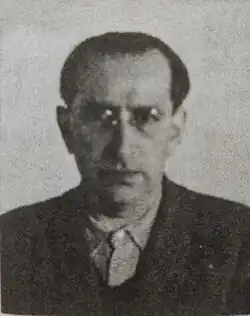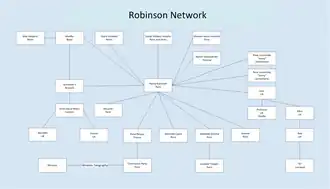Henry Robinson (spy)
Henry Robinson | |
|---|---|
 Henry Robinson after his arrest. | |
| Born | May 8, 1897 |
| Died | 1944 (aged 46–47) |
| Citizenship | Belgian |
| Occupation(s) | Section leader, communist agitator |
| Known for | Being part of the Red Orchestra ("Rote Kapelle") |
| Espionage activity | |
| Allegiance | Communist International |
| Service branch | AM Apparat |
| Service years | 1930-1942 |
| Codename |
|
Henry Robinson (8 May 1897 – 1944),[1] sometimes known as Henri Robinson or Henri Baumann was a Belgian Communist and later intelligence agent of the Communist International (Comintern). His real name is Arnold Schnee. Robinson was a leading member of the Red Orchestra, a Soviet espionage group based in Paris.[2] Robinson used a number of code names (Andre, Lucien, Leo, Giocomo) and aliases (Otto Wehrli, Albert Gottlieb Bucher, Alfred Merian, Harry Leon, Alfree Duyen, Harry Merian).[3]
Life

Born in Brussels, Robinson grew up in Saint-Gilles, Belgium[4] and was the child of wealthy Russian merchant David Robinson, born in Vilna Governorate and Polish mother Anna Cerhannovsky, who was born in Warsaw.[3] In his youth, he moved to France and received French citizenship.[5]
During World War I, Robinson studied jurisprudence at the University of Zurich[6] He learned to speak English, French, Russian, German and Italian.[5]
After the war, Robinson was associated with German communist Willi Münzenberg and Swiss communist Jules Humbert-Droz who had created the Young Communist League of Germany (KJVD).[6] 1920, Robinson became a member of the French Communist Party (PCF) and a member of the Communist Party of Germany (KPD). In the same year he met and married the German communist and KPD member Clara Schabbel,[5] and together the couple had a son, Leo, who was born in 1922.[a][5]
In 1920, the KJVD created the Young Communist International (KIM),[3] the youth wing of Communist International (Comintern).[6] In 1921 at the behest of the KPD and under the auspices of the KIM, he made several visits to the Soviet Union. In 1923, Robinson was sent to Germany where he was in charge of the Antimilitarist Apparatus or AM Apparat (Intelligence organisation) of the German Communist Party for military and political work in the Rhineland and was Political Director of the KIM in the Ruhr district of Germany, attending conferences in Berlin.[8] He took part in the fighting against the occupation of the Rhine and Ruhr area by French troops. This led to a French court sentencing him to 10 years in prison In Absentia.[5]
Between 1924 and 1928,, Robinson was director of the AM-Apparat of the Comintern for Central and Eastern Europe[8] which involved extensive travel between Germany, France, Low Countries and United Kingdom. In the same year, Robinson published a leaflet, under a pseudonym,Harry, along with Grigoriy Zinoviev, director of Comintern, titled: L'I.C.J. en luttle contre l'occupation de la Ruhr et la guerre ( The I.C.J. fights against the occupation of the Ruhr and the war).[9] Between 1928 and 1930, Robinson assisted General Muraille, Chief of Soviet espionage in France.[9]
Comintern
From about 1930, both worked for the intelligence service of the Comintern, which later merged with the Red Army's GRU intelligence service, and the Young Communist International.[10][11] Robinson became the section leader for Switzerland, France, and Great Britain.[12] [13] Schabbel maintained links to Berlin and, through the Soviet commercial agency there, provided communications to Moscow until June 1941.
In 1936, Robinson moved to Paris, where he worked with the Soviet Military attaché at the Soviet embassy.[14] While he was there, he was in contact with Maria Josefovna Poliakova and Rachel Dübendorfer in Geneva, Switzerland[14] where he liaised between groups in France, Switzerland and the Great Britain.[8]
During the period he was in Paris, another agent, who was not identified was running his own espionage network in France and the United Kingdom.[8] British intelligence gave the unknown agent the moniker HARRY II.[8] HARRY II was responsible for an agent in Great Britain, known as Ernest David Weiss who had been recruited in 1932.[14] In May 1936, HARRY II introduced Weiss to two other Soviet agents who worked at the Royal Aircraft Establishment in Farnborough, Hampshire.[15] In the same period, HARRY II introduced Weiss to Germaine Schneider a courier for the Soviet espionage network run by Leopold Trepper in France, Belgium and the Low Countries.[15] In 1937, the unknown agent Harry II handed his espionage network in the Great Britain over to Robinson.[15] Robinson arranged with Weiss to meet him in Jersey.[15] During 1938 Robinson visited the Great Britain several times to meet other agents. He also visited Belgium and Switzerland for the same purpose during 1938.[15]
From 1940, Robinson had been promoted to head of the AM Apparat for Western Europe.[3] Robinson ran an espionage network, known as group Harry, whose remit was to collect intelligence from French military and political groups, from within the Deuxième Bureau and within Vichy intelligence, from the Central Committee of the French Communist Party, from Gaullist groups and from UK groups.[16]
Trepper network
In September 1941, Robinson met with Soviet Red Army Intelligence agent, Leopold Trepper,[17] who at the time was technical director of Soviet Red Army Intelligence in western Europe.[18] Trepper had been ordered to take over command of Robinson's espionage network.[19]
There was an intense dislike between the two men due to Robinson being forced to hand over his network to Trepper when he arrived in France, even though Robinson was senior to Trepper. The Comintern organisation had lost prestige with Stalin who suspected it of deviating from Communist norms and Robinson was suspected of being an agent of the Deuxième Bureau and who was subsequently in ideological conflict with the aims of Soviet intelligence. This changeover had been facilitated in a meeting organised by General Ivan Susloparov. The group provided Trepper with intelligence on General Henri Giraud, the Dieppe Raid, coverage of Allied bombings in France and planning for Operation Torch.[20]
Arrest
On 20 December 1942 Robinson was arrested in Paris by the Sonderkommando Rote Kapelle.[21] According to British records, the RSHA had become aware of Robinson from information obtained from Leopold Trepper, whom they had previously arrested. According to Horst Kopkow of Reich Security Main Office AMT IV A2, Robinson was held in custody in France.{sfn|Kesaris|1979|p=343}} When the Sonderkommando arrested Clara Schabbel they discovered that their son was in the Wehrmacht.[22] The Gestapo brought Leo Schabbel, who had been wounded in the Eastern Front together with his father and threatened his life but Robinson refused to talk.[22] Robinson was then repeatedly tortured, before being brought to the Moabit detention centre in Germany to stand trial by General Judge of the Luftwaffe Manfred Roeder at the same time as Harro Schulze-Boysen.[7]
At the time of his arrest, four false passports were found in the possession of Robinson, as well as the Robinson papers.[23]
Robinson papers
The Robinson papers were over 800 papers contained in briefcases, that were found underneath the floorboards of a hotel room that Robinson had regularly used.[24] The originals had been lost but photostats had survived and these were sent by Abwehr IIF in France to Abwehrstelle Belgium, where they were captured during the British advance.[24] In 1966, British intelligence comment:
- the Robinson papers, apart from [Ernest David] Weiss, did not give any positive lead to spies in the UK. They do, indicate that Robinson played an important part in running Russian operations in the UK in the 1930s and it seems...
Many of the code names in the documents have never been identified.[24]
Note
Citations
References
- ^ SchafranekTuchel 2004, p. 100.
- ^ Wright & Greengrass 1988, p. 300.
- ^ a b c d Kesaris 1979, p. 341.
- ^ Bourgeois 1995, p. 85.
- ^ a b c d e Kochik 2006.
- ^ a b c West 2005, p. 229.
- ^ a b Kesaris 1979, p. 343.
- ^ a b c d e Kesaris 1979, p. 342.
- ^ a b Drachkovitch 1986, p. 399.
- ^ Coppi 1996, pp. 431–458.
- ^ "The Discovery Service: Henry Robinson". The National Archives (United Kingdom).
- ^ Day 2015, p. 182.
- ^ Andrew, Christopher (29 August 2000). The Sword and the Shield: The Mitrokhin Archive and the Secret History of the KGB. Basic Books. ISBN 9780465010035 – via Google Books.
- ^ a b c "Leopold TREPPER, aliases Leopold DOMB, Jean GILBERT (French), Adam MIKLER (Canadian)". The National Archives, Kew. p. 12. KV 2/2074. Retrieved 15 May 2021.
- ^ a b c d e "Leopold TREPPER, aliases Leopold DOMB, Jean GILBERT (French), Adam MIKLER (Canadian)". The National Archives, Kew. p. 13. KV 2/2074. Retrieved 15 May 2021.
- ^ Kesaris 1979, p. 89.
- ^ Kesaris 1979, p. 75.
- ^ "Leopold TREPPER, aliases Leopold DOMB, Jean GILBERT (French), Adam MIKLER (Canadian)". The National Archives, Kew. p. 14. KV 2/2074. Retrieved 26 October 2019.
- ^ Perrault 1969, p. 190.
- ^ Kesaris 1979, pp. 342–344.
- ^ "Nazi War Crimes Disclosure Act: Heinz Pannwitz debriefing" (PDF). CIA Library Electronic Reading Room. Archived from the original (PDF) on January 23, 2017.
- ^ a b Perrault 1969, p. 458.
- ^ Kesaris 1979, p. 344.
- ^ a b c Kesaris 1979, pp. 96–101.
Bibliography
- Bourgeois, Guillaume (1995). Les Kominterniens II (in French). Vol. II. Paris: L'Age d'homme. ISBN 9782825105887. OCLC 489619257.
- Coppi, Hans (1996). "Die "Rote Kapelle" im Spannungsfeld von Widerstand und nachrichtendienstlicher Tätigkeit. Der Trepper-Report vom Juni 1943" [The Red Orchestra in the field of resistance and intelligence activity. The Trepper Report of June 1943] (PDF). Vierteljahrshefte für Zeitgeschichte. 44 (3): 431–458.
- Day, Peter (9 July 2015). The Bedbug: Klop Ustinov: Britain's Most Ingenious Spy. Biteback Publishing. ISBN 9781849549462.
- Drachkovitch, Milorad M. (1986). Biographical Dictionary of the Comintern. Hoover Press. ISBN 978-0-8179-8403-8.
- Kesaris, Paul. L, ed. (1979). The Rote Kapelle: the CIA's history of Soviet intelligence and espionage networks in Western Europe, 1936–1945. Washington DC: University Publications of America. ISBN 978-0-89093-203-2.
- Kochik, Valery Yakovlevich (22 December 2006). "Арнольд Шнеэ, он же Анри Робинсон" [Arnold Schnee, aka Henri Robinson] (in Russian). Moscow: Konstantin Remchukov. Nezavisimaya Gazeta. Retrieved 18 August 2025.
- Perrault, Gilles (1969). The Red Orchestra. New York: Schocken Books. p. 190. ISBN 0805209522.
- Schafranek, Hans; Tuchel, Johannes (2004). Krieg im Äther. Widerstand und Spionage im Zweiten Weltkrieg [War in the ether. Resistance and espionage during World War II.]. Vienna: Picus. ISBN 3-85452-470-6.
- West, Nigel (2005). Mask: MI5's Penetration of the Communist Party of Great Britain. Hoboken: Taylor and Francis. ISBN 9780203696866.
- Wright, Peter; Greengrass, Paul (1988). Spycatcher : the candid autobiography of a senior intelligence officer. New York: Dell. ISBN 9780440201328.